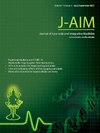Virtual screening and network pharmacology-based synergistic coagulation mechanism identification of multiple components contained in compound Kushen Injection against hepatocellular carcinoma
IF 1.7
Q3 INTEGRATIVE & COMPLEMENTARY MEDICINE
引用次数: 0
Abstract
Background
Hepatocellular carcinoma (HCC) is a primary liver malignancy commonly encountered in the setting of chronic liver disease and cirrhosis. Compound Kushen Injection (CKI) has been widely used in HCC, however, the underlying mechanisms are scarce.
Objective
To explore the molecular mechanisms of CKI for HCC.To explore the molecular mechanisms of CKI for HCC.
Materials and Methods
The chemical ingredients of CKI were reviewed from published articles and the potential targets were got from Herbal Ingredients’ Targets Platform. Coagulation-related targets were from Kyoto Encyclopedia of Genes and Genomes and HCC-related targets were from Therapeutic Target Database, Gene Expression Omnibus, and The Cancer Genome Atlas. Then the CKI-Herb-Target and CKI-Herb-Target-HCC networks were built. The shared targets between CKI and HCC were used for functional enrichment through Metascape and the shared coagulation-related target was used for molecular docking and survival analysis.
Results
A total of 23 chemical ingredients and 41 potential targets shared between CKI and HCC were obtained. The results of functional enrichment indicated that several canonical pathways of CKI mostly participated in the treatment of HCC. Furthermore, a chemical ingredient of CKI formed a stable hydrogen bond link with the ASN-189 on PLG, with a best binding energy of −4.7 kcal/mol. Finally, PLG was confirmed as the shared coagulation-related target and interrelated with the prognosis of HCC.
Conclusion
CKI probably improves HCC prognosis through PLG. Our research undoubtedly deepened the understanding of the molecular mechanism of CKI anti-HCC.
基于虚拟筛选和网络药理学的复方苦参注射液抗肝癌多成分协同凝血机制鉴定
背景:肝细胞癌(HCC)是一种原发性肝脏恶性肿瘤,常见于慢性肝病和肝硬化。复方苦参注射液(CKI)已被广泛用于治疗 HCC,但其潜在机制尚不清楚:探索复方苦参注射液治疗 HCC 的分子机制:从已发表的文章中查阅CKI的化学成分,从中药成分靶点平台中获取潜在靶点。凝血相关靶点来自京都基因组百科全书,HCC相关靶点来自治疗靶点数据库、基因表达总库和癌症基因组图谱。然后建立了 CKI-Herb-Target 和 CKI-Herb-Target-HCC 网络。通过 Metascape 对 CKI 和 HCC 的共享靶点进行功能富集,并对凝血相关的共享靶点进行分子对接和生存分析:结果:共获得 23 种化学成分和 41 个潜在靶点。功能富集结果表明,CKI 的几条典型通路大多参与了 HCC 的治疗。此外,CKI的一种化学成分与PLG上的ASN-189形成了稳定的氢键连接,最佳结合能为-4.7 kcal/mol。最后,PLG被证实是凝血相关的共有靶点,并与HCC的预后相关:结论:CKI 可通过 PLG 改善 HCC 的预后。我们的研究无疑加深了对CKI抗HCC分子机制的理解。
本文章由计算机程序翻译,如有差异,请以英文原文为准。
求助全文
约1分钟内获得全文
求助全文
来源期刊

Journal of Ayurveda and Integrative Medicine
INTEGRATIVE & COMPLEMENTARY MEDICINE-
CiteScore
4.70
自引率
12.50%
发文量
136
审稿时长
30 weeks
 求助内容:
求助内容: 应助结果提醒方式:
应助结果提醒方式:


